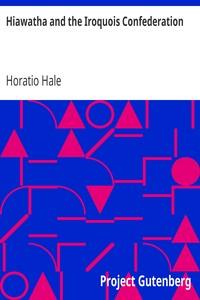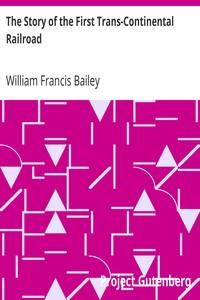Read this ebook for free! No credit card needed, absolutely nothing to pay.
Words: 8526 in 2 pages
This is an ebook sharing website. You can read the uploaded ebooks for free here. No credit cards needed, nothing to pay. If you want to own a digital copy of the ebook, or want to read offline with your favorite ebook-reader, then you can choose to buy and download the ebook.


: Hiawatha and the Iroquois Confederation A Study in Anthropology. A Paper Read at the Cincinnati Meeting of the American Association for the Advancement of Science in August 1881 under the Title of A Lawgiver of the Stone Age. by Hale Horatio - Iroquois Ind
tion was to retain its own council and its management of local affairs, the general control was to be lodged in a federal senate, composed of representatives elected by each nation, holding office during good behavior, and acknowledged as ruling chiefs throughout the whole confederacy. Still further, and more remarkably, the confederation was not to be a limited one. It was to be indefinitely expansible. The avowed design of its proposer was to abolish war altogether. He wished the federation to extend until all the tribes of men should be included in it, and peace should everywhere reign. Such is the positive testimony of the Iroquois themselves; and their statement, as will be seen, is supported by historical evidence.
Hiawatha's first endeavor was to enlist his own nation in the cause. He summoned a meeting of the chiefs and people of the Onondaga towns. The summons, proceeding from a chief of his rank and reputation, attracted a large concourse. "They came together," said the narrator, "along the creeks, from all parts, to the general council-fire." But what effect the grand projects of the chief, enforced by the eloquence for which he was noted, might have had upon his auditors, could not be known. For there appeared among them a well-known figure, grim, silent and forbidding, whose terrible aspect overawed the assemblage. The unspoken displeasure of Atotarho was sufficient to stifle all debate, and the meeting dispersed. This result, which seems a singular conclusion of an Indian council--the most independent and free-spoken of all gatherings--is sufficiently explained by the fact that Atotarho had organized among the more reckless warriors of his tribe a band of unscrupulous partisans, who did his bidding without question, and took off by secret murder all persons against whom he bore a grudge. The knowledge that his followers were scattered through the assembly, prepared to mark for destruction those who should offend him, might make the boldest orator chary of speech. Hiawatha alone was undaunted. He summoned a second meeting, which was attended by a smaller number, and broke up as before, in confusion, on Atotarho's appearance. The unwearied reformer sent forth his runners a third time; but the people were disheartened. When the day of the council arrived, no one attended. Then, continued the narrator, Hiawatha seated himself on the ground in sorrow. He enveloped his head in his mantle of skins, and remained for a long time bowed down in grief and thought. At length he arose and left the town, taking his course toward the southeast. He had formed a bold design. As the councils of his own nation were closed to him, he would have recourse to those of other tribes. At a short distance from the town he passed his great antagonist, seated near a well-known spring, stern and silent as usual. No word passed between the determined representatives of war and peace; but it was doubtless not without a sensation of triumphant pleasure that the ferocious war-chief saw his only rival and opponent in council going into what seemed to be voluntary exile. Hiawatha plunged into the forest; he climbed mountains; he crossed a lake; he floated down the Mohawk river in a canoe. Many incidents of his journey are told, and in this part of the narrative alone some occurrences of a marvellous cast are related even by the official historians. Indeed, the flight of Hiawatha from Onondaga to the country of the Mohawks is to the Five Nations what the flight of Mohammed from Mecca to Medina is to the votaries of Islam. It is the turning point of their history. In embellishing the narrative at this point, their imagination has been allowed a free course. Leaving aside these marvels, however, we need only refer here to a single incident which may well enough have been of actual occurrence. A lake which Hiawatha crossed had shores abounding in small white shells. These he gathered and strung upon strings, which he disposed upon his breast, as a token to all whom he should meet that he came as a messenger of peace. And this, according to one authority, was the origin of wampum, of which Hiawatha was the inventor. That honor, however, is one which must be denied to him. The evidence of sepulchral relics shows that wampum was known to the mysterious moundbuilders, as well as in all succeeding ages. Moreover, if the significance of white wampum-strings as a token of peace had not been well known in his day, Hiawatha would not have relied upon them as a means of proclaiming his pacific purpose.
Early one morning he arrived at a Mohawk town, the residence of the noted chief Dekanawidah, whose name, in point of celebrity, ranks in Iroquois tradition with those of Hiawatha and Atotarho. It is probable that he was known by reputation to Hiawatha, and not unlikely that they were related. According to one account Dekanawidah was an Onondaga, adopted among the Mohawks. Another narrative makes him a Mohawk by birth. The probability seems to be that he was the son of an Onondaga father, who had been adopted by the Mohawks, and of a Mohawk mother. That he was not of pure Mohawk blood is shown by the fact, which is remembered, that his father had had successively three wives, one belonging to each of the three clans, Bear, Wolf, and Turtle, which compose the Mohawk nation. If the father had been a Mohawk, he would have belonged to one of the Mohawk clans, and could not then have married into it. He had seven sons, including Dekanawidah, who, with their families, dwelt together in one of the "long houses" common in that day among the Iroquois. These ties of kindred, together with this fraternal strength, and his reputation as a sagacious councillor, gave Dekanawidah great influence among his people. But, in the Indian sense, he was not the leading chief. This position belonged to Tekarihoken whose primacy as the first chief of the eldest among the Iroquois nations was then, and is still, universally admitted. Each nation has always had a head-chief, to whom belonged the hereditary right and duty of lighting the council-fire, and taking the first place in public meetings. But among the Indians, as in other communities, hereditary rank and personal influence do not always, or indeed ordinarily, go together. If Hiawatha could gain over Dekanawidah to his views, he would have done much toward the accomplishment of his purposes.
In the early dawn he seated himself on a fallen trunk, near the spring from which the inhabitants of the long-house drew their water. Presently one of the brothers came out with a vessel of elm-bark, and approached the spring. Hiawatha sat silent and motionless. Something in his aspect awed the warrior, who feared to address him. He returned to the house, and said to Dekanawidah, "a man, or a figure like a man, is seated by the spring, having his breast covered with strings of white shells." "It is a guest," replied the chief; "go and bring him in. We will make him welcome." Thus Hiawatha and Dekanawidah first met. They found in each other kindred spirits. The sagacity of the Mohawk chief grasped at once the advantages of the proposed plan, and the two worked together in perfecting it, and in commending it to the people. After much discussion in council, the adhesion of the Mohawk nation was secured. Dekanawidah then despatched two of his brothers as ambassadors to the nearest tribe, the Oneidas, to lay the project before them. The Oneida nation is deemed to be a comparatively recent offshoot from the Mohawks. The difference of language is slight, showing that their separation was much later than that of the Onondagas. In the figurative speech of the Iroquois, the Oneida is the son, and the Onondaga is the brother, of the Mohawk. Dekanawidah had good reason to expect that it would not prove difficult to win the consent of the Oneidas to the proposed scheme. But delay and deliberation mark all public acts of the Indians. The ambassadors found the leading chief, Odatshehte, at his town on the Oneida creek. He received their message in a friendly way, but required time for his people to consider it in council. "Come back in another day," he said to the messengers. In the political speech of the Indians, a day is understood to mean a year. The envoys carried back the reply to Dekanawidah and Hiawatha, who knew that they could do nothing but wait the prescribed time. After the lapse of a year, they repaired to the place of meeting. The treaty which initiated the great league was then and there ratified between the representatives of the Mohawk and Oneida nations. The name of Odatshehte means "the quiver-bearer;" and as Atotarho, "the entangled," is fabled to have had his head wreathed with snaky locks, and as Hiawatha, "the wampum-seeker," is represented to have wrought shells into wampum, so the Oneida chief is reputed to have appeared at this treaty bearing at his shoulder a quiver full of arrows.
The Onondagas lay next to the Oneidas. To them, or rather to their terrible chief, the next application was made. The first meeting of Atotarho and Dekanawidah is a notable event in Iroquois history. At a later day, a native artist sought to represent it in an historical picture, which has been already referred to. Atotarho is seated in solitary and surly dignity, smoking a long pipe, his head and body encircled with contorted and angry serpents. Standing before him are two figures which cannot be mistaken. The foremost, a plumed and cinctured warrior, depicted as addressing the Onondaga chief, holds in his right hand, as a staff, his flint-headed spear,--the ensign which marks him as the representative of the Kanienga, or "People of the Flint,"--for so the Mohawks style themselves. Behind him another plumed figure bears in his hand a bow with arrows, and at his shoulder a quiver. Divested of its mythological embellishments, the picture rudely represents the interview which actually took place. The immediate result was unpromising. The Onondaga chief coldly refused to entertain the project, which he had already rejected when proposed by Hiawatha. The ambassadors were not discouraged. Beyond the Onondagas were scattered the villages of the Cayugas, a people described by the Jesuit missionaries, at a later day, as the most mild and tractable of the Iroquois. They were considered an offshoot of the Onondagas, to whom they bore the same filial relation which the Oneidas bore to the Mohawks. The journey of the advocates of peace through the forest to the Cayuga capital, and their reception, are minutely detailed in the traditionary narrative. The Cayugas, who had suffered from the prowess and cruelty of the Onondaga chief, needed little persuasion. They readily consented to come into the league, and their chief, Akahenyonk, "the wary spy," joined the Mohawk and Oneida representatives in a new embassy to the Onondagas. Acting probably upon the advice of Hiawatha, who knew better than any other the character of the community and the chief with whom they had to deal, they made proposals highly flattering to the self-esteem which was the most notable trait of both ruler and people. The Onondagas should be the leading nation of the confederacy. Their chief town should be the federal capital, where the great councils of the league should be held, and where its records should be preserved. The nation should be represented in the council by fourteen senators, while no other nation should have more than ten. And as the Onondagas should be the leading tribe, so Atotarho should be the leading chief. He alone should have the right of summoning the federal council, and no act of the council to which he objected should be valid. In other words, an absolute veto was given to him. To enhance his personal dignity two high chiefs were appointed as his special aids and counsellors, his "secretaries of state," so to speak. Other insignia of pre?minence were to be possessed by him; and, in view of all these distinctions, it is not surprising that his successor, who, two centuries later, retained the same prerogatives, should have been occasionally styled by the English colonists "the emperor of the Five Nations." It might seem, indeed, at first thought, that the founders of the confederacy had voluntarily placed themselves and their tribes in a position of almost abject subserviency to Atotarho and his followers. But they knew too well the qualities of their people to fear for them any political subjection. It was certain that when once the league was established, and its representatives had met in council, character and intelligence would assume their natural sway, and mere artificial rank and dignity would be little regarded. Atotarho and his people, however, yielded either to these specious offers or to the pressure which the combined urgency of the three allied nations now brought to bear upon them. They finally accepted the league; and the great chief, who had originally opposed it, now naturally became eager to see it as widely extended as possible. He advised its representatives to go on at once to the westward, and enlist the populous Seneca towns, pointing out how this might best be done. This advice was followed, and the adhesion of the Senecas was secured by giving to their two leading chiefs, Kanyadariyo and Shadekaronyes , the offices of military commanders of the confederacy, with the title of door-keepers of the "Long-House,"--that being the figure by which the league was known.
The six national leaders who have been mentioned--Dekanawidah for the Mohawks, Odatshehte for the Oneidas, Atotarho for the Onondagas, Akahenyonk for the Cayugas, Kanyadariyo and Shadekaronyes for the two great divisions of the Senecas--met in convention near the Onondaga Lake, with Hiawatha for their adviser, and a vast concourse of their followers, to settle the terms and rules of their confederacy, and to nominate its first council. Of this council, nine members were assigned to the Mohawks, a like number to the Oneidas, fourteen to the lordly Onondagas, ten to the Cayugas, and eight to the Senecas. Except in the way of compliment, the number assigned to each nation was really of little consequence, inasmuch as, by the rule of the league, unanimity was exacted in all their decisions. This unanimity, however, did not require the suffrage of every member of the council. The representatives of each nation first deliberated apart upon the question proposed. In this separate council the majority decided; and the leading chief then expressed in the great council the voice of his nation. Thus the veto of Atotarho ceased at once to be peculiar to him, and became a right exercised by each of the allied nations. This requirement of unanimity, embarrassing as it might seem, did not prove to be so in practice. Whenever a question arose on which opinions were divided, its decision was either postponed, or some compromise was reached which left all parties contented.
The first members of the council were appointed by the convention,--under what precise rule is unknown; but their successors came in by a method in which the hereditary and the elective systems were singularly combined, and in which female suffrage had an important place. When a chief died or was deposed for incapacity or misconduct, some member of the same family succeeded him. Rank followed the female line; and this successor might be any descendant of the late chief's mother or grandmother,--his brother, his cousin or his nephew,--but never his son. Among many persons who might thus be eligible, the selection was made in the first instance by a family council. In this council the "chief matron" of the family, a noble dame whose position and right were well defined, had the deciding voice. This remarkable fact is affirmed by the Jesuit missionary Lafitau, and the usage remains in full vigor among the Canadian Iroquois to this day. If there are two or more members of the family who seem to have equal claims, the nominating matron sometimes declines to decide between them, and names them both or all, leaving the ultimate choice to the nation or the federal council. The council of the nation next considers the nomination, and if dissatisfied, refers it back to the family for a new designation. If content, the national council reports the name of the candidate to the federal senate, in which resides the power of ratifying or rejecting the choice of the nation; but the power of rejection is rarely exercised, though that of expulsion for good cause is not unfrequently exerted. The new chief inherits the name of his predecessor. In this respect, as in some others, the resemblance of the Great Council to the English House of Peers is striking. As Norfolk succeeds to Norfolk, so Tekarihoken succeeds Tekarihoken. The great names of Hiawatha and Atotarho are still borne by plain farmer-councillors on the Canadian Reservation.
When the League was established, Hiawatha had been adopted by the Mohawk nation as one of their chiefs. The honor in which he was held by them is shown by his position on the roll of councillors, as it has been handed down from the earliest times. As the Mohawk nation is the "elder brother," the names of its chiefs are first recited. At the head of the list is the leading Mohawk chief, Tekarihoken, who represents the noblest lineage of the Iroquois stock. Next to him, and second on the roll, is the name of Hiawatha. That of his great colleague, Dekanawidah, nowhere appears. He was a member of the first council; but he forbade his people to appoint a successor to him. "Let the others have successors," he said proudly, "for others can advise you like them. But I am the founder of your league, and no one else can do what I have done."
The boast was not unwarranted. Though planned by another, the structure had been reared mainly by his labors. But the Five Nations, while yielding abundant honor to the memory of Dekanawidah, have never regarded him with the same affectionate reverence which has always clung to the name of Hiawatha. His tender and lofty wisdom, his wide-reaching benevolence, and his fervent appeals to their better sentiments, enforced by the eloquence of which he was master, touched chords in the popular heart which have continued to respond until this day. Fragments of the speeches in which he addressed the council and the people of the league are still remembered and repeated. The fact that the league only carried out a part of the grand design which he had in view is constantly affirmed. Yet the failure was not due to lack of effort. In pursuance of his original purpose, when the league was firmly established, envoys were sent to other tribes to urge them to join it or at least to become allies. One of these embassies penetrated to the distant Cherokees, the hereditary enemies of the Iroquois nations. For some reason with which we are not acquainted--perhaps the natural suspicion or vindictive pride of that powerful community--this mission was a failure. Another, despatched to the western Algonquins, had better success. A strict alliance was formed with the far-spread Ojibway tribes, and was maintained inviolate for at least two hundred years, until at length the influence of the French, with the sympathy of the Ojibways for the conquered Hurons, undid to some extent, though not entirely, this portion of Hiawatha's work.
His conceptions were beyond his time, and beyond ours; but their effect, within a limited sphere, was very great. For more than three centuries the bond which he devised held together the Iroquois nations in perfect amity. It proved, moreover, as he intended, elastic. The territory of the Iroquois, constantly extending as their united strength made itself felt, became the "Great Asylum" of the Indian tribes. Of the conquered Eries and Hurons, many hundreds were received and adopted among their conquerors. The Tuscaroras, expelled by the English from North Carolina, took refuge with the Iroquois, and became the sixth nation of the League. From still further south, the Tuteloes and Saponies, of Dakota stock, after many wars with the Iroquois, fled to them from their other enemies, and found a cordial welcome. A chief still sits in the council as a representative of the Tuteloes, though the tribe itself has been swept away by disease, or absorbed in the larger nations. Many fragments of tribes of Algonquin lineage--Delawares, Nanticokes, Mohicans, Mississagas,--sought the same hospitable protection, which never failed them. Their descendants still reside on the Canadian Reservation, which may well be styled an aboriginal "refuge of nations,"--affording a striking evidence in our own day of the persistent force of a great idea, when embodied in practical shape by the energy of a master mind.
"This was the roll of you-- You that were joined in the work, You that confirmed the work, The GREAT PEACE."
The regard of Englishmen for their Magna Charta and Bill of Rights, and that of Americans for their national Constitution, seem weak in comparison with the intense gratitude and reverence of the Five Nations for the "Great Peace" which Hiawatha and his colleagues established for them.
Free books android app tbrJar TBR JAR Read Free books online gutenberg
More posts by @FreeBooks


: The Story of the First Trans-Continental Railroad Its Projectors Construction and History by Bailey William Francis - Railroads United States History; Union Pacific Railroad Company







